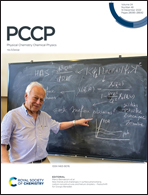Disentangling the resonant Auger spectra of ozone: overlapping core-hole states and core-excited state dynamics†
Abstract
We investigate the resonant and non-resonant Auger spectra of ozone with a newly implemented multi-reference protocol based on the one-center approximation [Tenorio et al., J. Chem. Theory Comput. 2022, 18, 4387–4407]. The results of our calculations are compared to existing experimental data, where we elucidate the resonant Auger spectrum measured at 530.8 and 536.7 eV, that correspond to the 1sOT → π*(2b1) and 1sOT → σ*(7a1) resonances, and at 542.3 eV, which lies near the 1sOC → σ*(7a1) excited state and above the 1sOT−1 ionization threshold. Using molecular dynamics simulations, we demonstrate the relevance of few-femtoseconds nuclear dynamics in the resonant Auger spectrum of ozone following the 1sOT → π*(2b1) core-excitation.

- This article is part of the themed collections: Recent Advances in Modelling Core-Electron Spectroscopy and 2022 PCCP HOT Articles


 Please wait while we load your content...
Please wait while we load your content...